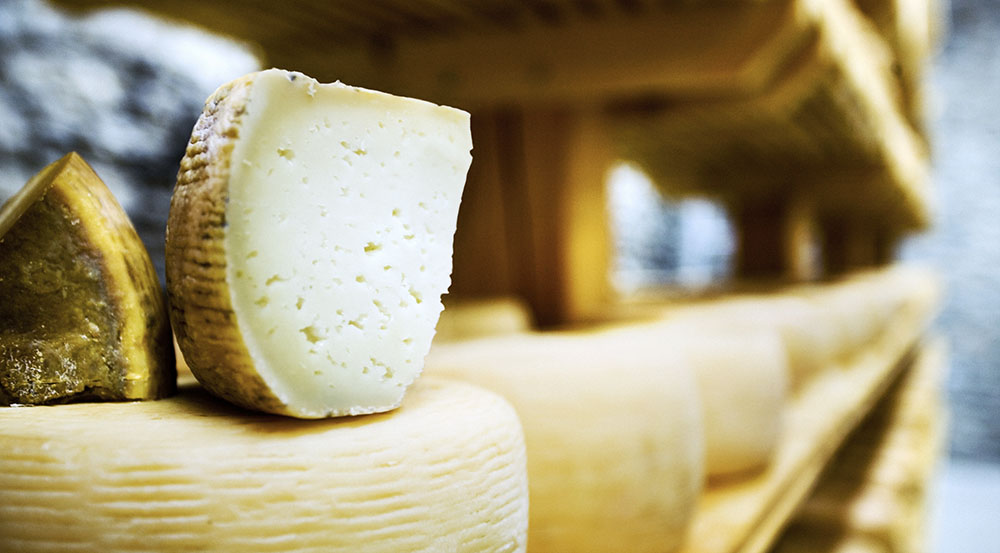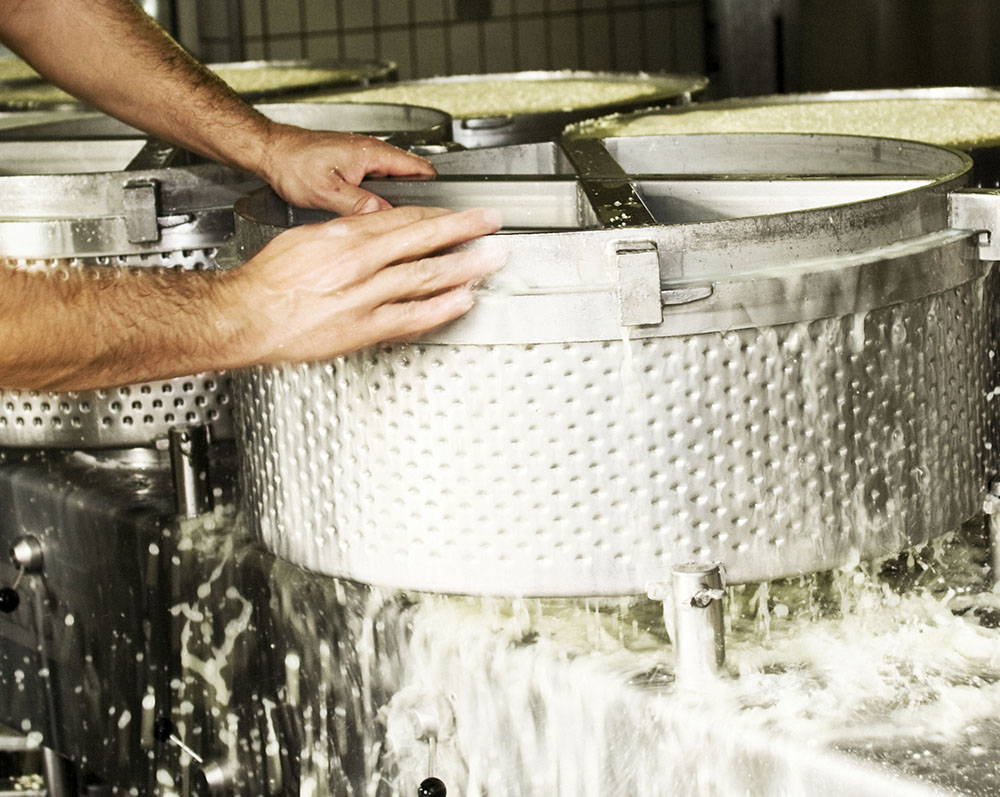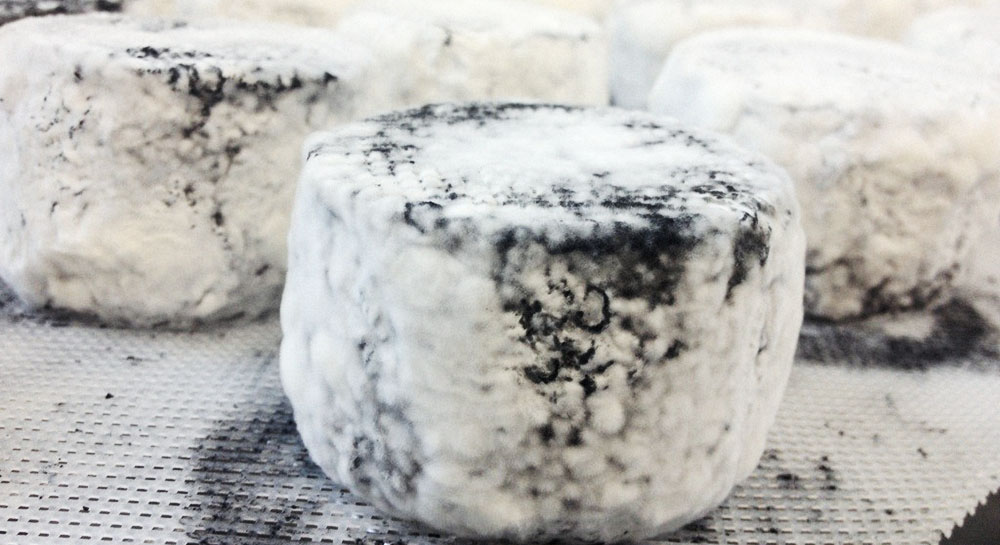
Making cheese in Canada is a treat. We have access to some of the best ingredients — especially if you consider that it was the export of Canadian milk in 1864 that launched the commercial production of cheese, pulling it away from its farm-made roots (towards which we’re now veering back).
“I have always been interested in using the ingredients that nature supplies to produce the finest possible foods, and love making things from scratch,” says Debra Amrein-Boyes, co-owner of The Farm House Natural Cheeses. “I started cheesemaking while living in the Swiss Alps, using the milk produced in the alpine meadows above our village. In 2002, my husband and I decided to diversify our small, family dairy farm in British Columbia. That’s when we started cheesemaking in earnest!”
Amrein-Boyes is part of La Guilde internationale des Fromagers, Confrerie de St Uguzon; she is only one of 12 people in North America who can claim to be a member. “It is a great honour to have been inducted into the Guilde, and to be counted among some of the world’s finest cheesemakers and supporters of the craft of cheesemaking,” Amrein-Boyes states.
At The Farm House Natural Cheeses, they make cow’s- and goat’s-milk cheeses, all certified organic and ranging across all the styles. “We produce …. fresh spreadable and semi-soft cheeses through to firm and hard varieties,” says Amrein-Boyes. “We are … known for our traditional cloth-bound Cheddar and our Heidi, which is a seasonal Alpine-style cheese made only from the summer milk, when the cows are grazing the lush fields of the Fraser Valley.”
Patricia Bertozzi from Fifth Town Artisan Cheese Company in Prince Edward County shares Amrein-Boyes’ sentiments about Canada’s history for providing the best ingredients. “Eastern Ontario has had some of the earliest Canadian farms in barley, apples, milk and cheese. It is an agricultural area that has seen many changes over the years, including the closure and consolidation of most of the small cheese-making dairies,” explains Bertozzi.

She and her brother decided to open Fifth Town because she believes “it is essential for Canada to become self-sufficient in our food production. Recently, the Quinte region [an area that includes Belleville, Trenton and Prince Edward County], a longstanding and historically significant agricultural area in Ontario, has seen an explosion of local food, agri-tourism, the opening of more than 40 wineries, and a growing amount of breweries.”
Bertozzi’s Platinum LEED-certified estate produces soft, bloomy rind, washed rind and tomme-style goat’s-milk French cheeses, Italian-style goat’s-milk and buffalo’s-milk Taleggio, Parmesan, and Dutch-style Goudas (both plain and flavoured).
Canadian cheese now spans every European style available as well as some unique styles created here. It makes the question posed on a Canadian cheese website very appropriate:
“Why buy imported when you can enjoy hundreds of Canadian cheeses produced by local cheesemakers?”
One great way to try out all the cheesy goodness that Canada has to offer is through a cheese tasting. The first thing you need to know is the six types of cheese: firm, semi-soft, soft, fresh, blue-veined and hard.
Firm & Hard Cheeses
Firm cheeses contain 50 to 62 percent moisture and are firm (obviously) and elastic. They are not aged and fall at the milder end of the taste spectrum. According to Amrein-Boyes, they have undergone longer production methods to “lower the final moisture level in the paste.”
In contrast, hard cheeses have less than 50 percent moisture, making them harder to grate as well as good for aging and storing for several years. “A firm cheese could be a youngish Gouda,” says Bertozzi, “while a hard cheese could be a two-year Gouda or Parmigiano Reggiano.”
Semi-Soft Cheese
Semi-soft cheese production includes washing, brushing and natural rinds. They have between 62 and 67 percent moisture with a soft, creamy texture. These cheese are washed in brine with red smear and, for some cheeses, alcohol (though that’s not required). “Semi-soft cheeses are usually ready to eat within a few weeks, as the moisture content is higher, supporting faster ripening,” Amrein-Boyes explains.
Soft Cheese
Soft cheese has two types — bloomy rind or washed rind. Bloomy rind has a rich, creamy texture with a slight elasticity. Washed rind has the same characteristics, except that during the aging process, the cheese is regularly turned, brushed or washed in brine with beer, mead, wine or spirits. The moisture content falls between 67 and 80 percent. “Soft, unripened would be a burrata,” Bertozzi says. “A soft, ripened would be a Brie or Camembert.”
Fresh Cheese
These cheeses are meant to be eaten immediately, as they are quite, well, fresh. They have over 80 percent moisture content. Bertozzi uses cream cheese as an example. “Fresh cheeses are the simplest, and can be easily made at home for a great texture and flavour experience,” mentions Amrein-Boyes.
Blue-Veined Cheese
Blue-veined cheeses are a combination of styles, in a way. “[They] can be of semi-soft or even firm types, and are aided in ripening by the introduction of a certain type of mould” explains Amrein-Boyes. Production methods for blue-veined cheese follow the same process as semi-soft or firm cheeses. “A blue-veined cheese could be a soft or a firm cheese. For example, a soft Gorgonzola dolce or a harder Gorgonzola picante),” adds Bertozzi.
“These categories are used to classify cheeses based on their moisture content on a fat-free basis,” explains Bertozzi. “Other descriptive terms are then added based on the firmness and ripening characteristics, such as ripened, surface-ripened, blue-veined, unripened or fresh.”

It should be mentioned that there is a difference between Canadian-made and uniquely Canadian cheese. Both categories are made with 100 percent Canadian ingredients, however the former is made in a style brought to Canada from somewhere else in the world and the latter is a cheese style unique to Canada, one that’s been developed or created here.
“There really are only a certain number of processes for cheesemaking, so you can find similar types of cheese all over the world,” Amrein-Boyes explains. “What makes a cheese special is the local take on a traditional recipe, and the terroir influencing the flavour of the milk.”
“Until about 20 years ago, most Canadian cheeses and cheesemakers focused on cheddar,” explains Bertozzi. “Quebec led the way in the artisan cheese industry and developed European-style cheeses and [Quebecois cheesemakers] have won some major cheese awards both domestically and globally.”
According to the Canadian Cheese Directory, there are 1,050 cheeses made in Canada, with the majority falling into three types: firm (35 percent), soft (25 percent) or semi-soft (22 percent).
Choosing the right cheeses to serve at a tasting comes down to type and number. One strategy is to select one cheese from each category.
“Usually six cheeses on a board is a good start, chosen by texture, colour and ripeness, or intensity of flavours,” explains Bertozzi. “A soft goat chèvre (plain or flavoured), burrata or buffalo mozzarella; a blue (either a Brie style or a harder selection); an aged cheddar; a buffalo Gouda (like our international gold-medal winner Buffalina); a French-style crottin or Valençay-style goat cheese pyramid; and a hard, washed-rind tomme style.”
Amrein-Boyes agrees, though she suggests between five and seven different cheeses: “It’s tempting to try more, but the palate can become overwhelmed and confused.”
“There are so many fantastic Canadian cheeses to choose from,” she mentions. “My personal favourites are: Farm House Heidi (seasonal cow’s milk cheese); Farm House La Pyramide (a French-style goat’s milk cheese); Glengarry Cheesemaking’s Lancaster (a washed-rind cow’s milk cheese from Ontario); Fromagerie du Presbytère’s Laliberté (a bloomy-rind semi-soft cheese from Quebec); Zacharie Cloutier from Fromagerie Nouvelle-France (a firm sheep’s milk cheese from Quebec).”
Whether you choose to serve them one at a time or all at once on a board, having the right accompaniments makes a big impact. As with any tasting, the flavours can change depending on the pairings. Select a variety of crackers and breads that your guests can use to sample the cheeses — encourage them to change up the pairings, too, and make note of how that affects the flavour.
“Keeping the accompaniments simple allows the flavours of the cheeses to take centre stage,” Amrein-Boyes states. “I personally love artisan rye breads and simple oat crackers with cheese.”
For the beverages, wine is always a classic. You could even make the event a double tasting — wine and cheese. Pick out a white, rosé, red and maybe even a sparkling or dessert wine to sip throughout the night. Bertozzi suggests a lighter, citrusy wine for goat cheese, sweeter dessert wines for blue cheeses and “perhaps a local Pinot Noir or Cabernet Franc for the stronger aged cheeses.”
Never judge by appearance — or smell, for that matter,
cheese needs to be tasted to truly know its quality.
For non-wine lovers, serve up beer or cider. “Certain types of cheese, like the Goudas and cheddars, are also great with cider, beer and ale,” Amrein-Boyes mentions.
When you’re tasting, keep an eye out for the true qualities of a great cheese. “I look at texture or mouth feel, smell and, most importantly, taste,” says Bertozzi. “A lot of great cheese looks very ugly.” Never judge by appearance — or smell, for that matter — cheese needs to be tasted to truly know its quality.
And always keep in mind the talent and passion of the cheesemakers behind each piece. “What goes in, comes out,” explains Amrein-Boyes. “So, the highest quality and freshest milk is key to good cheese. That being said, a cheesemaker must pay strict attention to every detail of the process or things can go wrong quickly. An artisan cheesemaker is working with a raw ingredient that is different every day, so it helps to have that certain instinct — a feel for the craft.”
